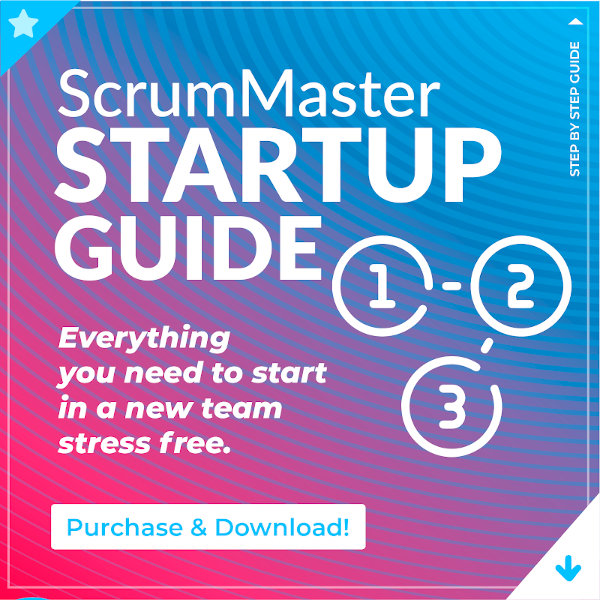What’s the difference between Scrum Master and Agile Coach roles?
Many see Scrum Master in a way as a junior Agile Coach. However, this is not the right approach to either of the roles.
Let me explain how the two roles are different… and how they are the same. Watch the video below.
Differences between Scrum Master and Agile Coach
I think the easiest way to explain what the differences and the similarities between the two roles are is with a simple table comparison.
Now, I am basing my inputs here on my personal experiences. This might be very different in your organization. However, I would argue that most organizations look at it that way.
And, of course, the column for the Scrum Master as per Scrum Guide role is the true Scrum Master role that Scrum Masters are supposed to play based on the Scrum Guide’s definition.
I know I am being a bit harsh here, but this is to get my point across.
Albeit, I’m giving a few examples – this is not really an exhaustive list in any way.
BUT…
If you want to have a better understanding of the true Scrum Master role, I encourage you to check out my Ultimate Scrum Guide in Practice (a.k.a. Scrum Master Startup Guide).
| Scrum Master as per Scrum Guide | Scrum Master in organizations | Agile Coach in organizations | |
| Works closely with the Scrum Team to help them become more effective | ✔ | ✔ | |
| Provides training and coaching to the Scrum Team | ✔ | ✔ | |
| Works closely with the Product Owner to help with Product Backlog | ✔ | ❔ | ❔ |
| Provides training and coaching to the Product Owner | ✔ | ❔ | ❔ |
| Works with stakeholders and management to help them understand Agile and Scrum | ✔ | ✔ | |
| Provides training and coaching to the whole organization | ✔ | ✔ | |
| Facilitates stakeholder collaboration with the team and the PO | ✔ | ❔ | |
| Works on improving and optimizing organizational processes | ✔ | ✔ |
I have used the “?” sign to represent the “It depends” case 🙂
One role or two roles?
What’s the conclusion here then?
Unfortunately, what often happens is, because the Scrum Master role is widely misunderstood, it is being fit into the existing hierarchical boundaries where one person can’t possibly work on the two levels (can they?)
So it becomes split into two parts: the “junior”-ish position where the person only works with the team, and the higher level position where the person works with management.
And this leads to more confusion and complexity, and reduces the benefits of Scrum and the Scrum Master.
I would say that the Agile Coach is also having trouble getting the best results because they are too far away from the teams, what’s happening in the field.
So whether your official role is that of an Agile Coach or a Scrum Master, you must operate on all levels to achieve real improvements and real results. It’s not really Scrum Master versus Agile Coach and the difference between them, but rather Scrum Master / Agile Coach.
How to be an Agile Coach as a Scrum Master
You are a Scrum Master, and your organization is limiting you to only work with the Scrum Team.
You might be asking yourself: what do I do in this situation?
Well, there is actually lots that you can do:
- Start with building relationships with the right people and find Agile allies who can support your cause on all levels.
- Create enough trust capital and credibility in your role that your leaders recognize your work.
- Help implement improvements that have a ripple effect on other teams.
That way, even if your organization officially limited you to just the Scrum Team, you can still operate on all levels and bring real positive change.
Get a mentor to support your career growth
Book a free discovery call with me to discuss how I can help you achieve your professional goals in Agile and Scrum.
As a licensed Professional Scrum Trainer I provide Agile and Scrum coaching and mentorship to help you develop your career and bring new solutions to your team!
Don’t you have both Agile Coach and Scrum Master in your LinkedIn profile?
If you look on my LinkedIn page (follow me, btw 😉), you’ll see that I marked Agile Coach and Scrum Master at different times of my career.
Let’s be honest, organizations continue to consider Agile Coach job as a higher level more senior role, so it’s important to align with those expectations when we present ourselves on the job market.
However, it doesn’t mean that when I was “just” a Scrum Master, I was only working with the team. As soon as I could I went outside of my comfort zone to work on all levels of the organization.
And you can do it too.
Want to learn more about becoming a Certified Professional Scrum Master Level I?
The online PSM1 Certification is a course where together we’ll discover Scrum from the point of view of a Scrum Master and the Scrum team.
The training material is created and maintained by the Scrum co-creator Ken Schwaber, Scrum.org and the community of Professional Scrum Trainers who teach the courses, helping to ensure that they are in tune with what’s happening in software development organizations and always up-to-date with the latest practices. It’s the highest quality Scrum training you can find rated 4.8 stars out of 5 on TrustPilot.
Check out the PSM1 Certification.




